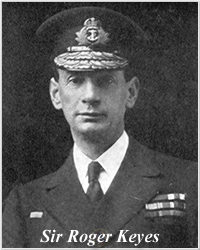 Sir Roger Keyes was born at Tundiani Fort, India on 04 October 1872. He joined the Royal Navy in 1885 as a Midshipman. By 1900 he was promoted to Commander for commendable actions undertaken during the Chinese Boxer Rebellion. He was promoted to Captain in June 1905.
Sir Roger Keyes was born at Tundiani Fort, India on 04 October 1872. He joined the Royal Navy in 1885 as a Midshipman. By 1900 he was promoted to Commander for commendable actions undertaken during the Chinese Boxer Rebellion. He was promoted to Captain in June 1905.
He served as the Naval Attaché, Rome, Vienna, Athens, and Constantinople from 1905 to 1907. Following this, he served as Commodore in charge of Submarines (1910-1914). He subsequently played a notable part in the planning for the successful Battle of Heligoland Bight on 28 August 1914. In 1915, he served as Chief of Staff Eastern Mediterranean Squadron. Though the Dardanelles expedition was not successful, Keyes did outstanding work and was Mentioned in Despatches. He also received the C.M.G., D.S.O., and Commander Legion of Honour.
In April 1917, Keyes was promoted to Rear Admiral. He was subsequently appointed as the Admiralty's Director of Plans. It was here that he made his biggest impact during the First World War: He planned operations designed to limit and possibly cut-off German U-boat operations in the Strait of Dover. Under his direction, operations were prepared for blocking the entrances to Zeebrugge and Ostend. Keyes's forces successfully blocked both ports in April 1918. He received the K.C.B., K.C.V.O., Grand Cross Order of Leopold, Grand Officer Legion of Honour, Croix de Guerre, French and Belgian and American DSM for his actions.
Following the war, Keyes was made a baronet. In late 1919, he took command of the Battle Cruiser Squadron and in early 1920 became the first Admiral to fly his flag in H.M.S. Hood. He left Hood in 1921 to serve as Deputy Chief of Staff and a Lord Commissioner of the Admiralty. He served in these roles until 1925, when he left to become Commander in Chief, Mediterranean Station. He was promoted to Admiral during this tour of duty.
In 1929, Keyes became Commander in Chief, Portsmouth Station. He held this position until 1931. During this timeframe, he had been promoted to Admiral of the Fleet (May 1930). He retired in 1935. In the meantime, he had become a Member of Parliament. He would hold his seat (conservative) from 1934 to 1943. During the early phases of World War 2, Keyes was highly critical of Prime Minister Chamberlain's lacklustre handling of the war.
In 1940, Keyes was replaced on the active list. He subsequently served as the Director of Combined Operations (until 1941). In January 1943 Keyes was elevated to the peerage and left Parliament. He died on 26 December 1945 at the age of 73.
Sources and References
"The Naval Memoirs of Admiral of the Fleet Sir Roger Keyes" (2 volumes, published 1934/1935)
Volume I - The Narrow Seas to the Dardanelles (1910-1915)
Volume II- Scapa Flow to the Dover Straits (1916-1918)
"Adventures Ashore & Afloat" (1939)